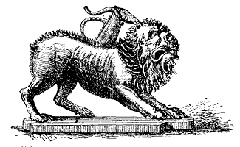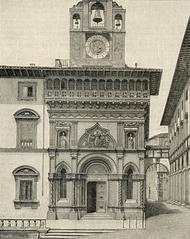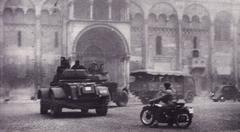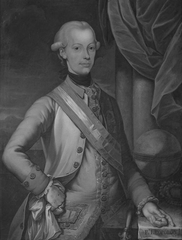Comprehensive Guide to Visiting Quartiere Di Porta Santo Spirito, Arezzo, Italy
Updated Date: 17/08/2024
Introduction to Quartiere Di Porta Santo Spirito
Welcome to the Quartiere di Porta Santo Spirito, a district that captures the essence of Arezzo’s rich historical tapestry. Nestled in Tuscany, Italy, this historic quarter, also known as the ‘quarter of the dove’ due to the dove of the Holy Spirit in its emblem, invites visitors to step back in time and experience its unique blend of architectural splendor, cultural vitality, and historical significance. The district’s origins trace back to the Etruscan period, with the consular Cassia Vetus road being a critical artery during the Roman era (Arezzo Notizie). Over centuries, it evolved through significant medieval and Renaissance developments, including the construction of defensive walls and the establishment of landmarks like the Santo Spirito monastery and hospital (Arezzo Notizie). Today, it stands as a vibrant community hub, known for hosting the renowned Giostra del Saracino, a jousting tournament that attracts visitors from around the world (Studentessa Matta). Whether you’re a history enthusiast, culture aficionado, or a curious traveler, Quartiere di Porta Santo Spirito offers a compelling glimpse into the past and an exciting array of attractions and events to explore.
Table of Contents
- Introduction
- Historical Background
- Architectural and Cultural Significance
- The Giostra del Saracino
- Preservation of Historical Sites
- Practical Visitor Information
- FAQ
- Conclusion
Visitor’s Guide to Quartiere di Porta Santo Spirito: History, Tickets, and Top Attractions in Arezzo
Introduction
Welcome to the Quartiere di Porta Santo Spirito, one of the four historic districts of Arezzo, Italy. Known for its rich history, architectural beauty, and vibrant cultural events, this district is a must-visit for anyone exploring Arezzo. In this guide, you’ll discover the historical background, practical visitor information, and top attractions of Quartiere di Porta Santo Spirito.
Historical Background
Origins and Evolution
The Quartiere di Porta Santo Spirito, also known as the “quartiere della Colombina” due to the dove of the Holy Spirit in its emblem, is one of the four historic districts of Arezzo. This area has a rich history that dates back to the Etruscan period. The most significant road leading into the city during this era was the consular Cassia Vetus, which maintained its importance through the Roman period and beyond (Arezzo Notizie).
Medieval Developments
In the early 12th century, the city of Arezzo was expanding rapidly, necessitating the construction of new defensive walls. The original city gate, known as Porta Burgi or Porta del Borgo, was relocated between 1194 and 1200 to a position near the current intersection of Via Garibaldi and Corso Italia (Arezzo Notizie). During the 14th century, under the rule of the Tarlati family, an even larger defensive perimeter was planned, culminating in the construction of a new southern entrance around 1319. This entrance was situated approximately at the intersection of Via Vittorio Veneto, Via Piave, and Via Leon Battista Alberti (Arezzo Notizie).
Renaissance and Beyond
The name “Santo Spirito” was adopted in the 16th century, derived from the nearby monastery of the Poor Clares, established in 1261/62. This monastery was located close to the eastern bastion of Porta Santo Spirito. Opposite the monastery stood the Santo Spirito hospital, which featured a beautifully frescoed portico, as described by Giorgio Vasari in his “Lives” of 1568 (Arezzo Notizie).
19th Century Transformations
In 1893, the original Porta Santo Spirito, also known as Porta Romana, was demolished. This demolition was part of a broader urban renewal plan approved by the City Council in 1891. The project, led by engineer Umberto Tavanti, resulted in the construction of two imposing buildings with opposing facades and a customs barrier gate named after King Vittorio Emanuele II. The materials from the demolished gate were repurposed, and a notable arch was relocated to the entrance of the Santa Maria delle Grazie sanctuary (Porta Santo Spirito).
Architectural and Cultural Significance
The emblem of the Quartiere di Porta Santo Spirito is a heraldic representation featuring a blue field with a three-arched bridge, surmounted by a letter “M” topped with a black cross, and crowned by a wall with three natural towers. Above this is the golden, radiant dove of the Holy Spirit (UICI Arezzo). The district’s colors are yellow and blue, and it is home to several noble families, including the Albergotti, Azzi, Camaiani, and Guasconi, as well as the Pazzi del Valdarno and Tolomei del Calcione from the countryside (UICI Arezzo).
The Giostra del Saracino
One of the most significant cultural events associated with Quartiere di Porta Santo Spirito is the Giostra del Saracino, a historical jousting tournament held twice a year in Arezzo. This event sees the district’s knights, known as Giostratori, compete against those from the other three districts for the coveted “lancia d’oro” or golden lance. The tournament is a reenactment of medieval jousting, where knights aim to strike a target representing the Saracen, an ancient enemy of Christianity (Studentessa Matta).
Modern-Day Celebrations and Community
Today, the Quartiere di Porta Santo Spirito continues to be a vibrant community, actively participating in various cultural and social events. The district’s headquarters are located in the eastern bastion of Porta Santo Spirito, and it hosts numerous activities, including the annual celebration of Pentecost at the Church of San Marco (Porta Santo Spirito). The district also honors its historical and cultural heritage through events such as the “Cavallino d’Oro” award, given annually to the best player of Arezzo’s football team (Porta Santo Spirito).
Preservation of Historical Sites
The Chiesina di Sant’Antonio Abate, located in the heart of Saione on Via Vittorio Veneto, is another significant site within the district. This church, now under the jurisdiction of the Parish of San Francesco Stimmatizzato di Saione, has been a place of devotion and prayer for the local community since its construction. It is also the official church of the Quartiere di Porta Santo Spirito, where the annual votive candle offering and the blessing of the Giostratori take place (Porta Santo Spirito).
Practical Visitor Information
Visiting Hours
Quartiere di Porta Santo Spirito is accessible to visitors year-round. Specific sites like the Church of San Marco and the Chiesina di Sant’Antonio Abate have varying visiting hours, so it’s best to check their official websites or contact the local tourist information center for the latest details.
Tickets
Most attractions within Quartiere di Porta Santo Spirito are free to visit. However, special events like the Giostra del Saracino may require tickets, which can be purchased online or at the event venue. Prices vary based on seating and event popularity.
Travel Tips
- Transportation: Arezzo is well-connected by train and bus. From the Arezzo train station, Quartiere di Porta Santo Spirito is a short walk or bus ride away.
- Nearby Attractions: Don’t miss the nearby Piazza Grande, the Cathedral of Arezzo, and the Basilica of San Francesco.
- Accessibility: Most sites within the district are accessible, but some historical buildings may have limited accessibility due to their age and structure.
- Guided Tours: Consider joining a guided tour to fully appreciate the historical and cultural significance of the district.
- Best Photographic Spots: Capture stunning views of the district from the eastern bastion of Porta Santo Spirito and the surrounding streets.
FAQ
What are the best times to visit Quartiere di Porta Santo Spirito?
The best times to visit are during the Giostra del Saracino in June and September, and the Pentecost celebrations in May or June.
Are there any guided tours available?
Yes, guided tours are available and highly recommended to gain in-depth knowledge of the district’s history and attractions.
Is Quartiere di Porta Santo Spirito family-friendly?
Absolutely! The district offers various family-friendly activities and events, especially during cultural festivals.
Conclusion
Quartiere di Porta Santo Spirito is a district steeped in history, from its origins in the Etruscan period to its modern-day cultural significance. Its rich architectural heritage, vibrant community life, and active participation in the Giostra del Saracino make it a fascinating area for visitors and locals alike. The district’s commitment to preserving its historical sites and traditions ensures that its legacy will continue to be celebrated for generations to come. By exploring Quartiere di Porta Santo Spirito, you not only witness the architectural marvels and cultural festivities but also connect with a community that cherishes its past while embracing the present. For more updates and to enhance your visit, download the Audiala app and follow us on social media.





